In the event of a crash, a motorcyclist is 21 times more likely to be killed or seriously injured than if they were in a car, over the same distance travelled.
Whilst the trend for serious crashes and fatalities for all other transport modes has been falling, despite increased activity, since the early 2000s motorcycle crash rates have risen.
According to the Ministry of Transport, in the ten years to the end of 2014 motor vehicle occupant deaths fell 39% while the number of cars, utes and vans rose by 12%.
Over the same period, motorcycle rider and pillion deaths rose 19% while the number of two-wheelers grew by 52%. That’s the bad news. The good news is it doesn’t have to be that way.
Other countries have made inroads into motorcycle safety. It was the experience in Victoria, Australia – along with protests here against rising ACC motorcycle levies – that led to the establishment of the Motorcycle Safety Advisory Council (MSAC) in 2011.
MSAC is an independent panel of motorcycle experts who oversee the $30 annual Motorcycle Safety Levy introduced at the same time, collected from motorcycle licence fees (but due to fall to $25 from July).
The special levy is ring-fenced to improve motorcycle safety; MSAC’s job is to advocate on behalf of motorcyclists, investigate initiatives that make riding safer and recommend to ACC where to invest the funds.
Projects MSAC has undertaken include research into making motorcycles more conspicuous on the road, assessing popular motorcycle routes from a ‘bike’s eye view’ to identify motorcycle-specific hazards, and developing a guide for roading authorities to make roads more motorcycle-friendly.
MSAC chairman, Mark Gilbert, says the group’s goal is to consider what needs to change to reduce the number of serious injuries and fatalities from motorcycle incidents.
“At the end of the day, we want all motorcyclists coming home.” Mr Gilbert is interested in the KiwiRAP programme, which has mapped the safety rating of the entire State Highway network, but MSAC wants to assess local roads popular with riders, which entails equipping motorcycles with cameras that specifically identify hazards from a rider's perspective.
The popular Southern Coromandel Loop was one of their first projects to be assessed this way. As a result, a number of improvements have been made to the route, including sealing property entrances along it to reduce the amount of loose gravel spilling onto the road, a major hazard for riders.
Other improvements included widening the edge line marking to provide better visual clues, better road markings on deceptive corners, and improving visibility by cutting back banks.
Via the Motorcycle Safety Levy, MSAC hopes to extend this type of assessment and treatment to other popular motorcycle routes, including the Northern Coromandel Loop, Pokeno (south of Auckland) to Raglan, the Rimutaka Hill Road between Wellington and Wairarapa, and the Christchurch to Akaroa route.
In late 2014, MSAC produced a guide targeted at roading authorities and contractors to help them design roads and infrastructure that are safer for riders.
Mr Gilbert says the document aims to “change the DNA around the way we do our road renewal work”, and help roading engineers consider issues which pose particular problems for riders, such as the location of roadside infrastructure, design of kerbs and roundabouts, road markings, and drainage.
“No one sees what they don’t see. You can be a good rider or a bad rider, but if the road gets you, it really doesn’t matter. We must try to eliminate surprises.”
MSAC has also researched improving motorcycle visibility, including whether innovative front lighting configurations make motorcycles more conspicuous, with the results of trials submitted to the Ministry of Transport for consideration.
Mr Gilbert's view is the current lighting regulations may not be flexible enough. “If you’re doing something to really make yourself stand out when you’re a high-risk road user, we’d hate to see penalties being applied,” he says.
Vehicle and rider safety equipment are also a focus for the organisation. While motorcycle safety equipment lags the vast improvement in cars, technology along with more rider training will play a key role in reducing motorcycle crashes and injuries.
Research by the Monash University Accident Research Centre shows that anti-lock braking systems (ABS) on motorcycles over 125cc can significantly reduce the number of bike accidents.
Mr Gilbert also wants to explore the idea of rewarding those riders who have safer motorcycles and advanced training.
“The more the rider does to upskill themselves, check their equipment and wear the right gear, the better. That might equal a lower ACC levy in future, so that we reward good behaviour.”
Reported by Mark Stockdale for our AA Directions Autumn 2016 issue




